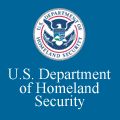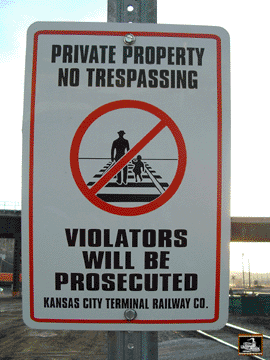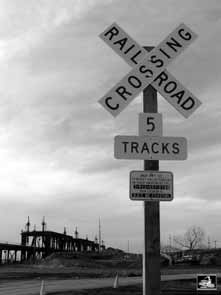Railfan Safety
& Legal Information
| Current
D.H.S. Threat Level | Railfan
Rights | Do's & Don'ts | Emergency
RR Phone Numbers |
| Reporting A Problem | Calling
911 |
This page is dedicated to looking at the dangers of our
hobby. The railroad industry is not a playground for little ones and grownups
alike. We must be always be aware of our surroundings. Trains are powerful,
heavy and cannot stop very quickly. That is why the smart railfan knows
not to be careless or take risks. Smart railfans are also considerate
of other railfans and respectful of private property.
Current
Dept. of Homeland Security Transportation Sec. Threat Level:

Click above for more information, dealing with
railfanning during different 'coded threat levels.'
 For
more legal and Threat Level Information, please visit the U.S. Department
of Homeland Security by clicking on the U.S.D.H.S. logo to the left.
For
more legal and Threat Level Information, please visit the U.S. Department
of Homeland Security by clicking on the U.S.D.H.S. logo to the left.
Please Note: The advisory
above is the current level from the U.S. Department of Homeland Security
(DHS). The DHS has no affiliation with the TrainPixs Network, the info
provided here is for use for planning a railfanning trip.
top
Your
Rights As A Railfan
TRAINS Magazine looks into our real rights
as railfans. Originally printed in the October 2006 issue. CLICK
HERE to read the story.
top
Do's
& Don'ts
ALWAYS expect a train, this is the most
important rule of railfanning, especially critical when you're in an area
with multiple tracks where the sound of one train can mask the sound of
a second train on the other set of tracks. If you must cross the tracks,
cross them at approved crossing. Crossing in the middle of the tracks
puts you at risk of tripping on the rails or slopping on icy ballast.
There is no margin for error if a train is approaching.
 DO
NOT trespass on rail property. Rail yards are private property.
Never enter them without permission. If asked to leave, do so without
being rude. Also, don't trespass on someone else's property, just to get
that perfect shot. Seek out legal places for taking photos, video, etc.
DO
NOT trespass on rail property. Rail yards are private property.
Never enter them without permission. If asked to leave, do so without
being rude. Also, don't trespass on someone else's property, just to get
that perfect shot. Seek out legal places for taking photos, video, etc.
DO NOT climb on rail equipment. Even
a freight car that is standing on a siding and is not attached to a train
can be dangerous.
DO NOT try to cross the tracks between
cars of a stopped train or hop a freight car; the train may begin moving
at any moment and if you lose your footing, you might seriously hurt yourself
or worse!
ALWAYS be courteous to other railfans,
try not to step into someone else's photo line of sight. Don't talk loudly
as a train approaches in case someone else is trying to record the sounds.
DO NOT walk along tracks or on bridges
or in tunnels. They are private property first off and you might not hear
an approaching train. And clearances in bridges and tunnels can be tight
and you may not be able to escape an approaching train.
DO NOT stand close to the tracks. A
train is at least three feet wider than the tracks on each side. In addition,
a fast moving train may kick up ballast. Coal could be dislodged from
an open hopper. Metal straps used to secure cargo may come loose and pose
a danger to people standing too close to the tracks.
IT'S UP TO YOU! As a railfan, you know
how a typical railroad operates in your area; if you have seen anything
that is out of the ordinary on a train (or around the right-of-way), stay
calm and report the incidents to the railroad and the appropriate authorities.
BE A ROLE MODEL! It is human nature
for people to imitate others. Be sure that you use common sense and also
follow all the rules, especially when it deals with children. Even if
you are at a tourist line act like it is a Class 1 mainline — if
a child see you doing something there, they might try to imitate it somewhere
else!
Recommended Material to have on person when you're
railfanning, "The Photographer's Rights," by Bert P. Krages II,
attorney at law. You can download a .PDF version HERE*
[thephotographersright.pdf (147KB)] Also, cell phone and a First Aid Kit
should be on hand just incase someone gets injured.
NOTE: Some cities and states have
placed post-9/11 laws into effect (please review this
handout* [railfanSafety+SecurityAdvisory.pdf (1.97MB)] by Operation
Lifesaver); if a police officer asks you to move and/or questions
you, don't freak out. Stay calm, be nice and helpful; tell the person
what your doing, and offer them some identification — the worst
thing to do is start a confrontation.
top
EMERGENCY
Railroad Phone Numbers
Listed below are toll-free emergency numbers for major
North American railroads. A following section is provided for you to record
emergency numbers for regional and shortline railroads in your area.
Major places of locating emergency numbers are
- Placards on grade crossings
- The railroad's official Web site, if it has one
- Operation Lifesaver (see later in this chapter) materials distributed
by the railroad
Calling the following numbers is typically more efficient
than trying to contact a local office of the railroad, which may or may
not be staffed at any given time.
| Railroad
Corporation |
Telephone
Number(s) |
| Amtrak (NEC) |
(800) 331-0008 |
| BNSF Railway |
(800) 832-5452 |
CN Railway |
(800) 465-9239
|
| Conrail (CSX/NS
shared asset areas) |
(800) 272-0911 |
| Canadian Pacific
Railroad |
(800) 716-9132 |
| CSX |
(800) 232-0144 |
| Norfolk Southern
Railroad |
(800) 453-2530 |
Union Pacific
Railroad |
(888) 877-7267 |
Numbers were obtained from various sources, including
railroads' Web sites in 2002. Some railroads may have multiple numbers,
on a region-by-region basis, primarily as the result of previous mergers
or multiple dispatching centers.
Please note that in areas affected by recent mergers
(such as the previous Conrail areas) or spin-offs of lines to a shortline
operator, it may take some time for emergency numbers posted at grade
crossings to reflect the current situation.
top
Reporting
A Problem
When calling in a report, do not try to immediately provide every bit
of information. Rather, begin by identifying yourself and giving a quick
summary of the problem:
Example: "Hello. My name is [your name]. I
am calling from [city and state, or region of state, such as northeastern
Kansas] to report [nature of the incident: vandalism, hazardous situation,
accident, crime in progress, etc.]."
Identifying yourself is extremely important in giving credibility to
your report. Do not identify yourself as a railfan. That is completely
irrelevant to the report you are making.
The person receiving your call will then either ask you to provide more
details or hand you off to another person, such as the dispatcher or railroad
police supervisor handling the particular area. Do not use
the word "emergency" unless you are reporting a situation
that requires immediate action (such as stopping trains) to avoid injury,
loss of life, or destruction of property.
The single most important fact you can provide about a hazardous incident
is the precise location—in terms relevant to the railroad. In most
cases, street or highway names are not particularly relevant to the railroad.
If at all possible, report the location in terms of railroad mileposts.
If you know railroad names for a location, include those. If not sure
of the location, give it in terms of distance (and direction) from a nearby
city or town. Mileposts typically have alphabetical prefixes (though often
not shown on the physical milepost markers) which designate the applicable
line. If possible include that.
 Many
grade crossings will have identification plate—such as the photo
to your right. If the incident you are reporting is at or near a grade
crossing, be sure to get the grade crossing identification number. The
plate will typically also include the milepost and prefix for that location.
Many
grade crossings will have identification plate—such as the photo
to your right. If the incident you are reporting is at or near a grade
crossing, be sure to get the grade crossing identification number. The
plate will typically also include the milepost and prefix for that location.
Examples: "I am at milepost H-54;" "I am on the Orin
line at the milepost 14.7 crossovers;" "The broken rail is approximately
ten miles west of [name of town];" "A large tree has fallen
onto the tracks about a mile west of the grade crossing with the following
identification number …."
If the problem applies to a moving train, you need to identify
- The problem
- The train (including direction!)
- The location in the train
You can identify trains several ways.
- If you are absolutely sure, give the train's number or alphanumeric
identifier. (Typically you will hear this on a scanner, as the train
identifies itself in radio transmissions.)
- If you know the number of the lead engine (or any engine in the consist),
give that.
- If you do not know either of the above, give the time you saw the
train, the location at which you saw it, and the direction in which
the train was operating. In multi-track territory, give the track on
which the train was operating. For the latter, you can simply state
that the train was on the [eastern, southern, etc. of the two tracks].
- If you do not know any of the above information,
don't be afraid to state that you don't know. Don't guess.
The location within a train is very important. If you
spot a problem on a moving train, try to note the type of car. (Chances
are that you will not be able to record the full reporting marks of the
car, but even noting the owner will help.) Immediately begin counting
cars to the end of the train. The crew on the head end of the train will
need to check the problem and need to know its location relative to the
head end. But, if you can provide a count of the number of cars from the
end, they can easily subtract from the known number of cars in the train.
Examples: "I saw smoke coming from the front truck of a black UTLX
tank car approximately 43 cars from the end of the train;" "I
saw tie-down chains dragging on the left side of a yellow bulkhead flat
car 12 cars from the end of the train;" "I saw liquid leaking
from a white tank car about 20 cars from the end of the train.
NOTE: On a fast-moving intermodal train with cars consisting
of multiple articulated platforms, you may not be able to determine which
locations between platforms are articulated and which have couplers. In
that case count platforms. Railroads usually assume that the typical person
reporting a hazard is not familiar with articulated cars and will assume
that a car count is actually a platform count.
Pinpointing the location within a train can help the crew stop the train
for quick access by emergency responders. For example, for a fire on a
railcar (or an overheated brake or bearing that could cause a fire) the
crew can try to stop the train with the affected car at or near a grade
crossing, where the local fire department can reach it quickly.
If you are calling to report a stationary problem along the right of
way, such as a mud slide, washed out area, broken rail, or tree fallen
onto track, indicate whether you can stay in the area to point out the
site to responding railroad workers. If so, provide some identifying features,
such as, "I am in a red pickup truck and wearing a dark blue windbreaker.
If you are calling from a cellular phone in your vehicle, be sure to give
that number so that so that the responding crews can contact you from
their cell phones.
If you do not have access to a cellular telephone or cannot establish
a cellular connection from a remote rural area, you may have to hunt for
a public telephone or a telephone at a nearby residence. Do not
count on remembering all pertinent information. Write it down!
If you do not have note paper handy, but do have a pen, write on your
hand.
top
Calling
911
If the situation you are reporting involves a crime, injuries to railroad
personnel or nearby residents, or a fire or leak of hazardous materials,
also call 911 or whatever the local emergency number is. (While railroad
police may have primary jurisdiction, railroad police are often spread
very thin, and it may take some time for a railroad officer to reach the
scene.) However, if the incident requires the railroad to stop trains
to avoid further damage or injuries, call the railroad emergency number
first.
top
* Adobe Acrobat is required to view these files. You can download a free
version here.
